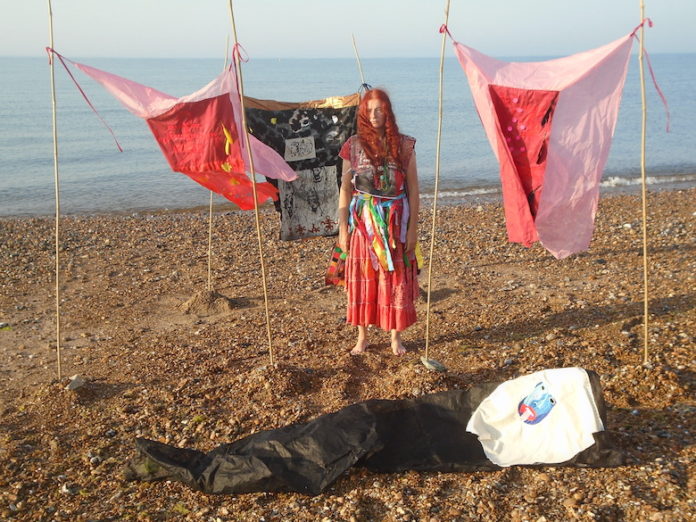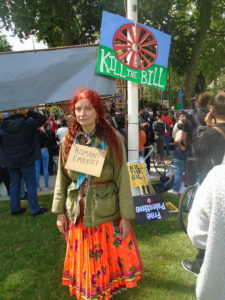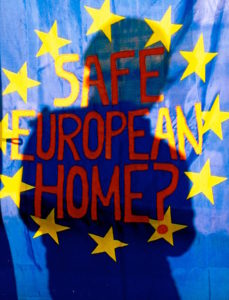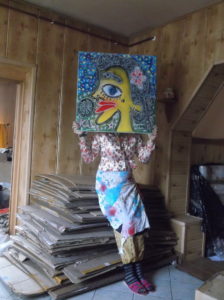An incredible woman, strong, valiant and creative. An exceptional Romani artist. A loving sister and friend. Only with Delaine can we visit the Romani Embassy, which has an eye on the world. This is how artist Małgorzata Mirga-Tas described her fellow artist Delaine Le Bas. This is how Mirga-Tas envisions the immediate future, as a time of leadership of strong, wise female Romani activists, artists and political operatives who have an increasing role not only in the Roma community, but in society as a whole. Le Bas was born in the United Kingdom, she holds a MA from St. Martin’s School of Art in London and exhibits all around the world – at the American Visionary Art Museum in Baltimore, USA, the International Festival of Singular Art in Roquevaire, France, and the 1st Roma Pavilion of the 52ndVenice Biennale.
Her works deal with issues of exclusion, identity, stereotypes, untold history, gender and class, and she stands out with – among other things – her recognizable clothing, playing with motifs and colorful textiles with which she repeatedly questions cultural and identity qualities. Speaking about stereotypes, Le Bas maintains that they are noticeable in art which sees the Roma as naughty and negative characters, but also in romanticized depictions of a barefoot woman, whose black hair flutters in the wind, while she runs in the field banging on a tambourine.
All that led to stereotypes that are so embedded within society that generally everyone thinks they know who we are more than we do ourselves. But there are now so many people working from the community that our own way of representing ourselves is becoming more and more visible but there is still much more work to be done and we can never be complacent. We cannot expect or rely on anyone else to make the changes and we must use every means that we have to work towards changing perceptions on all levels.
Le Bas was among the sixteen artists presented as part of the first Roma pavilion at the Venice Biennale in 2007, she was the curator and artistic director of the first Roma Biennale in 2018, and the artistic curator at the Roma Trial. The dream of her husband, Damian Le Bas, about a Roma biennial dedicated to Romani art became reality in the spring of 2018 in Berlin. Delaine worked with him on several projects, including the Safe European Home?, the Gypsy Revolution and Gypsy DaDa, and together they produced stage pieces and costumes for the Roma Armee musical at the Maxim Gorky Theater in Berlin.
First I am an artist, I was part of the Roma Pavilion in 2007 & 2019 as an artist, this is my main position. My late husband was the initiator of the Roma Biennale and sadly he died just before we were to start the first Roma Biennale. I have worked with Roma Trial and together with Hamze Bytyci as joint curators for the current Biennale and the first one. From my own perspective, from the beginning, I wanted to create a space not only for the artists but also for maybe a different way of doing things. Damian and I had this idea that why should you have to wait to be asked to an art event, why not create our own and also not to be restricted by financial constraints – at this time the posters that have been produced for the 2nd Roma Biennale 2021 can be downloaded from the website so, in theory, you can have the Roma Biennale in your own home.
They were both aware that as a community they must try and work towards a consistent presence that breaks what and who the wider community thinks they are; but to do this it needs to constantly pulsate in everyone’s consciousness, otherwise it is forgotten.
It has always also been my intention that this would also involve other curators and different formats. Like that we would be able to be flexible enough even in the process and to react to current events, in some ways bringing parts of my artistic practice into this flexible approach.
The 1st Roma Biennale COME OUT NOW! was a project by RomaTrial e. V. in cooperation with the Maxim Gorki Theater / Studio Я for the Alliance for Solidarity with the Sinti and Roma of Europe. Le Bas also participates in the preparation and realization of the second Roma Biennale WE ARE HERE! which began on the International Romani Day on April 8th this year and lasts until October 24 when a monument dedicated to Sinti and Roma, victims of the Nazi regime, was unveiled in Berlin in 2012.
The Roma Art Movement is very diverse with many artists working cross-practice from many countries. This creates a multiplicity of dimensions to the works and a complexity of voices to be heard. Sometimes the artworks and the politics cross over and often the artists – just by their mere presence within different spheres of the world – can create new dialogues about what perception is and this, in turn, adds to a momentum towards social justice and new ways of seeing who we are. But it really means that everyone has to work at what they do best in their individual areas in order to create a collective impact. Collaboration not only with each other but also with others is also important in order to push forward.
Le Bas is the author of many exhibitions and international projects, and among them is Romani Embassy, which acts as a living archive and starting point, but also as a work of art and activism. Romani Embassy is an ongoing installation and performance, conceived as an idea for Gypsy Revolution at HIAP Residency Suomenlinna Helsinki, Finland in 2012, first embodied as performance for When The Fuel Runs Out People Will Need Horses in London June 2015. Inspired by the Indigenous Rights Movement in Australia, when four Aboriginal people set up a beach umbrella on the lawn in front of the House of Parliament in Australia in 1972, Le Bas points out that Roma do not have “one homeland” or a nation state, so while they are in many countries around world, they are not fully accepted in none of them.
We are an embodiment of an international population, we have many religions, we speak many languages and speak many versions of our own language. We have little self- representation politically and no Embassy anywhere to run to in times of trouble.
Despite her rich experience in leading and preparing art programs and initiatives, as well as her activist engagement, Le Bas puts her artistic identity first, which is ultimately intertwined with all other layers of her work listed here.
I always say I am artist, my work is multi-layered, and is made up of all the facets of who I am, what I have and continue to experience, and how I feel in this world. This often touches on so many things it is difficult to distill it down to just a few components.














